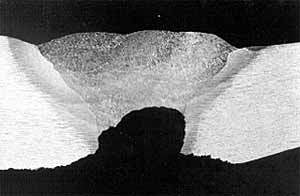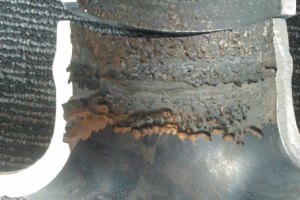Welding corrosion is a form of corrosion rather than a corrosion mechanism. It is a synergetic effect of corrosive environment and welding metallurgy. Although it is difficult to determine the particular reasons of corroding, one or more of the following items are often major contributing factors for such process:
 Microstructural /compositional difference caused by welding metallurgy
Microstructural /compositional difference caused by welding metallurgy- Residue stress by poor welding practice
- Weldment geometry by poor welding quality or welding design
Welding corrosion is widely identified in oil and gas industry, either upstream or downstream. Some typical welding corrosion types are:
- Preferential HAZ corrosion (Tramline corrosion)

- Preferential Weld metal corrosion
- Stress corrosion cracking
- Hydrogen induced cracking
Welding Corrosion Prevention
Post weld heat treatment (PWTH)
- Relevant of ASME code
- The applicable construction code
- An approved alternative PWHT procedure, including:
- metallurgical review (reason for the original PWHT, SCC, stress in location of the weld, HIC, creep etc.)
- welding method selection (construction code, adequacy of the weld in the as-welded condition)
- ASME P-number and Group Number designation
- Materials initially required PWHT, should be post weld heat treated.
Local post weld heat treatment is applicable if procedure is reviewed by experienced and specialised engineer, in which covers
- Base metal thickness
- Decay thermal gradient
- Materials properties
- Change due to PWHT
- need for full penetration weld
- Examination after local PWHT
- Overall and local strains and distortions resulting from the heating
- 150oC or higher is maintained during the welding, monitored by at least 2 suitable thermocouples
- A distance of not less than two times of base metal thickness measured from toe of the weld.
- Controlled heat input to nozzels or attachments within the PWHT
Preheat or controlled deposition welding methods can be applied as an alternatives to postweld heat treatment:
- Preheating Method (Notch Toughness testing not required)
- temperature of weld area should be preheated and maintained at 150oC as minimum
- range of 100 mm or four times of the materials thickness (whichever is greater) on each side of groove
- maximum interpass temperature should not exceed 600F (315oC)
- Controlled -deposition welding method ( Notch Toughness testing required)
- may be used in lieu of PWHT
- Notch toghness testing is required if ASME code section VIII, D1 UG-84 UCS-66 required impact test.
- The materials should be limited to P-N0.1, P-No.3 and P-No.4 steel
- Welding methods: SMAW, GMAW and GTAW
- Weld procedure spec shall be developed and qualified for each application (pretreat temperature, interpass temperature, post heating temperature, no steel with %C >0.35 or lower strength)
- PQR should be sufficient if impact test is required by code (toughness of metal and HAZ @MDMT, hardness etc)
- WPS, which may include
- the supplementary essential variable of ASME code, section IX,
- the maximum weld heat input for each layer by PQR
- the minimum preheat temperature for welding by PQR
- the maximum interpass temperature for welding by PQR
- the preheating area (4in or 4 times of thickness each side)
- HIC concern (filler metal and electrode with H8 or lower; shielding gas with dew points lower than -50oC; dry surface, rust and hydrocarbon free)
- welding techniques should be within PQR (controlled deposition, temper-bead or half bead technique
- SMAW using hydrogen diffusion treatment by maintaining temperature at 230~290oC 2 hours ( may omit for H4 grade filler metal and electrode)
- finish repair by removal of final temper bead reinforcement layer and flushing with the base metal surface
The good source of information can be found in “Corrosion of Weldments” (Davis, 2006)

Thanks for ones marvelous posting! I genuinely enjoyed reading it, you may be a great author.I will make sure to bookmark your blog and definitely will come back sometime soon. I want to encourage yourself to continue your great work, have a nice afternoon!